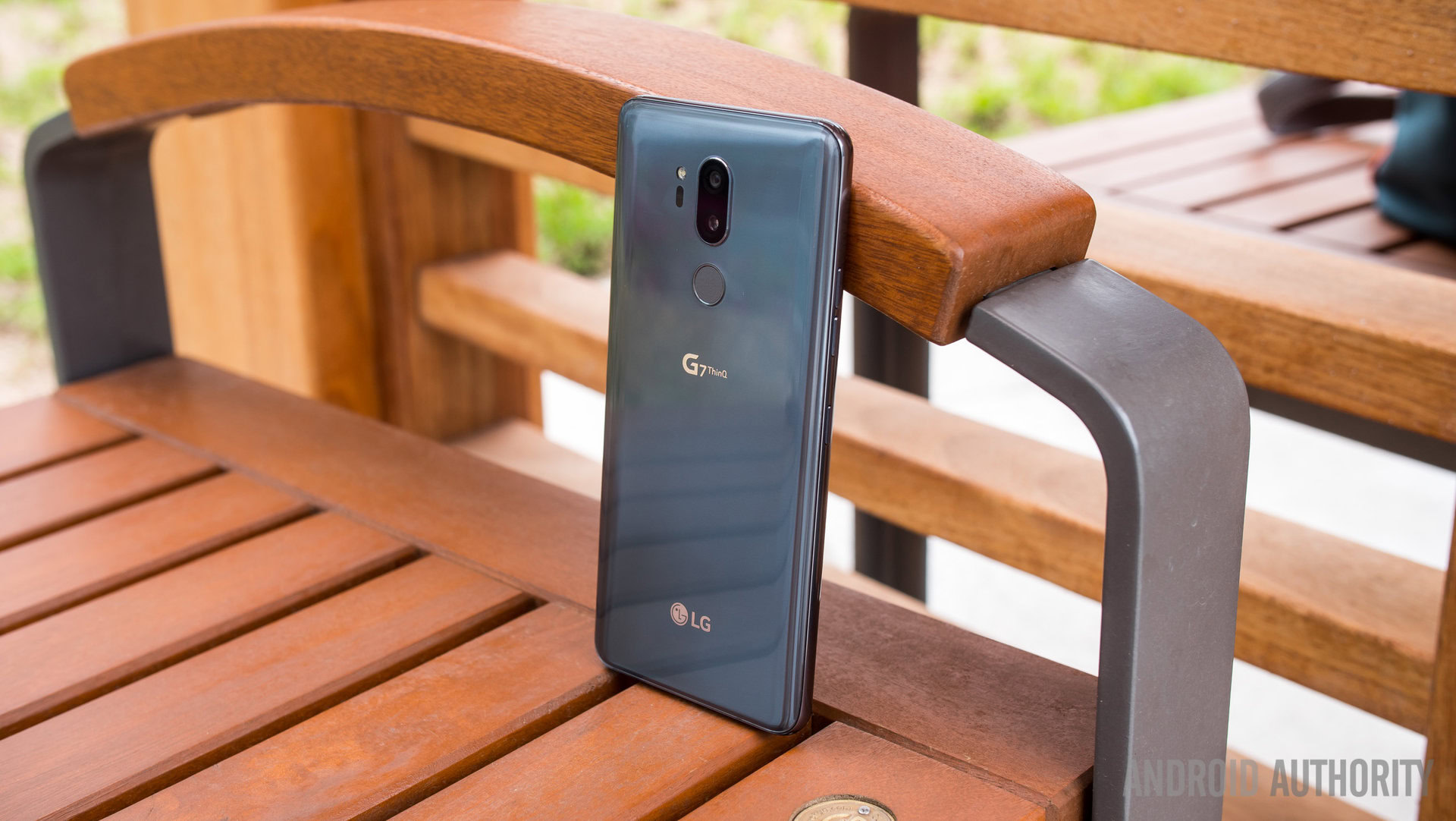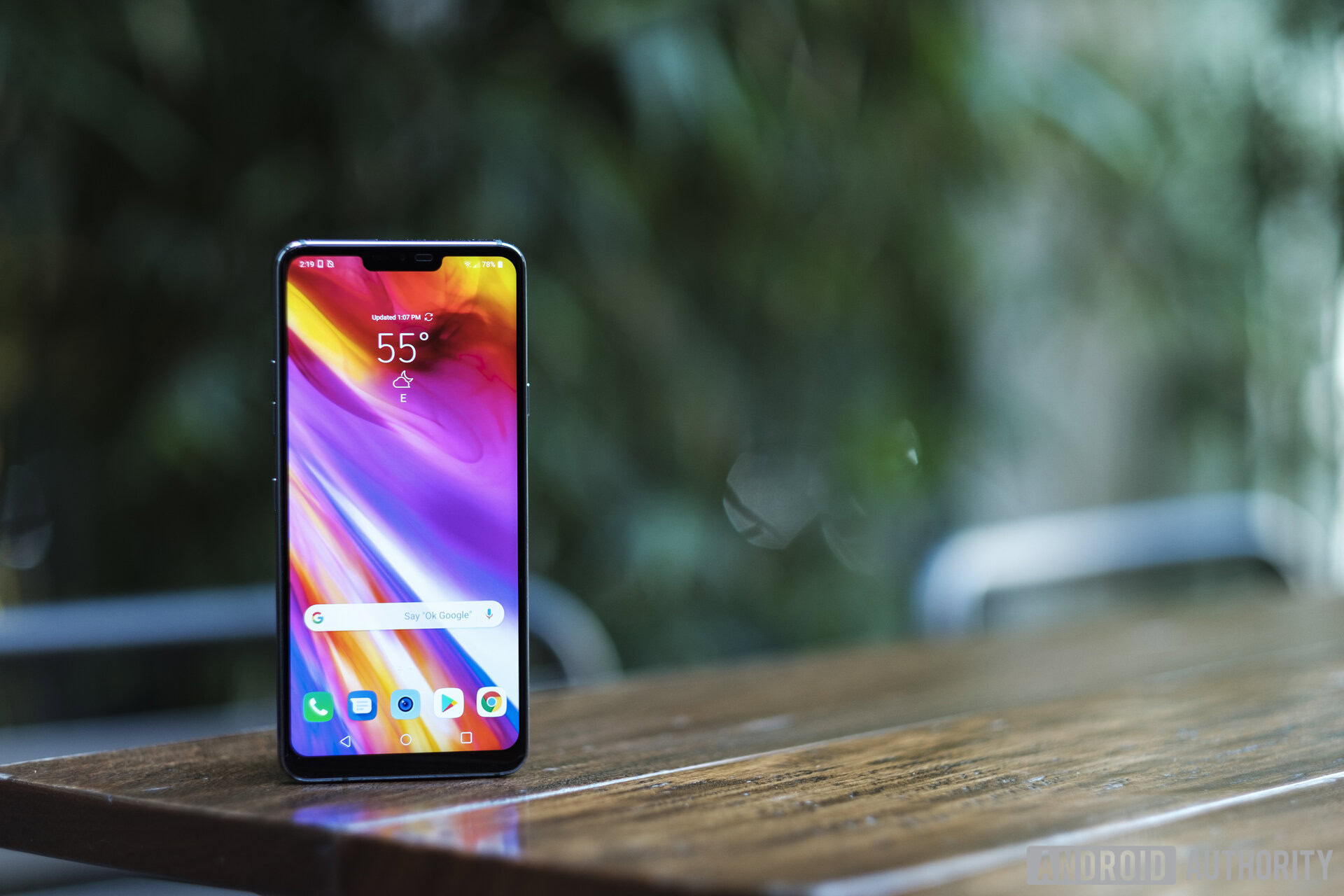Affiliate links on Android Authority may earn us a commission. Learn more.
LG G7 ThinQ vs the competition: How does LG's best fare against the rest?

The brand new LG G7 ThinQ is the company’s first big step in adopting its new mobile strategy. It’s not the biggest hardware revision we’ve seen, but it has the makings of a capable 2018 flagship, from the latest Snapdragon processor to the controversial notch.
How well does LG‘s latest and greatest stack up to the competition, namely the Samsung Galaxy S9 Plus, Google Pixel 2 XL, HUAWEI P20 Pro, and the iPhone X? Let’s take a closer look at the on-paper differences between these handsets.
Read more:
The LG G7 ThinQ bucks the OLED trend, opting instead for a 3,120 x 1,440 resolution IPS LCD display. The Galaxy S9 Plus, Pixel 2 XL, P20 Pro, and even the iPhone X all feature OLED displays. Whether that is a good or bad thing depends on your taste. OLED displays are known for their inky blacks, saturated colors, power efficiency, and superiority for VR purposes.
OLED also tends to be more expensive and more prone to screen burn-in than LCD. It has a tendency to exaggerate colors, too.
| LG G7 ThinQ | Samsung Galaxy S9 Plus | Google Pixel 2 XL | |
|---|---|---|---|
Display | LG G7 ThinQ 6.1-inch LCD FullVision display 3,120 x 1,440 resolution 1,000-nit brightness 19.5:9 aspect ratio | Samsung Galaxy S9 Plus 6.2-inch Curved Super AMOLED 2,960 x 1,440 resolution 529ppi 18.5:9 aspect ratio | Google Pixel 2 XL 6.0-inch P-OLED 2,880 x 1,440 resolution 538ppi 18:9 aspect ratio |
SoC | LG G7 ThinQ Qualcomm Snapdragon 845 | Samsung Galaxy S9 Plus Global: Samsung Exynos 9810 U.S.: Qualcomm Snapdragon 845 | Google Pixel 2 XL Qualcomm Snapdragon 835 |
GPU | LG G7 ThinQ Adreno 630 | Samsung Galaxy S9 Plus ARM Mali-G72 (Exynos) Adreno 630 (Snapdragon) | Google Pixel 2 XL Adreno 540 |
RAM | LG G7 ThinQ 4/6GB | Samsung Galaxy S9 Plus 6GB | Google Pixel 2 XL 4GB |
Storage | LG G7 ThinQ 64/128GB microSD expansion | Samsung Galaxy S9 Plus 64/128/256GB microSD expansion up to 400GB | Google Pixel 2 XL 64/128GB No microSD slot |
Cameras | LG G7 ThinQ Rear Main camera: 16MP sensor, f/1.6 aperture, 71-degree field of view Secondary camera: 16MP sensor, f/1.9 aperture, Crystal Clear lens, 107-degree field of view Front 8MP sensor, f/1.9 aperture | Samsung Galaxy S9 Plus Rear Main camera: 12MP sensor, f/1.5 and f/2.4 apertures, OIS Secondary camera: 12MP, f/2.4 aperture, OIS, telephoto (2x zoom) Front 8MP sensor, f/1.7 aperture | Google Pixel 2 XL Rear 12.2MP sensor, f/1.8 aperture, OIS Front 8MP sensor, f/2.4 aperture |
Audio | LG G7 ThinQ Boombox Speaker DTS:X 3D Surround Sound Hi-Fi Quad DAC 3.5mm headphone jack | Samsung Galaxy S9 Plus 3.5mm headphone jack Stereo speakers Tuned by AKG | Google Pixel 2 XL No headphone jack Audio over USB Type-C Front stereo speakers |
Battery | LG G7 ThinQ 3,000mAh | Samsung Galaxy S9 Plus 3,500mAh | Google Pixel 2 XL 3,520mAh |
IP rating | LG G7 ThinQ IP68 | Samsung Galaxy S9 Plus IP68 | Google Pixel 2 XL IP67 |
Software | LG G7 ThinQ Android 8.0 Oreo | Samsung Galaxy S9 Plus Android 8.0 Oreo | Google Pixel 2 XL Android 8.1 Oreo |
Dimensions and weight | LG G7 ThinQ 153.2 x 71.9 x 7.9mm 162g | Samsung Galaxy S9 Plus 158.1 x 73.8 x 8.5mm 189g | Google Pixel 2 XL 157.9 x 76.7 x 7.9mm 175g |
Colors | LG G7 ThinQ Platinum Gray, Aurora Black, Moroccan Blue, Raspberry Rose | Samsung Galaxy S9 Plus Midnight Black, Coral Blue, Lilac Purple, Titanium Grey | Google Pixel 2 XL Just Black, Black & White |
On the topic of displays, the G7 ThinQ, P20 Pro, and iPhone X feature notches, while the Galaxy S9 Plus and Pixel 2 XL do not.
Unlike with the iPhone X, the LG G7 ThinQ and P20 Pro allow you to “turn off” the notch by blacking out the status bar. The P20 Pro’s notch-less setting will probably look better than the G7 ThinQ’s in the real world, thanks to the deeper blacks OLED provides. Of course, we can’t definitively say this yet.
The notch allows the G7 ThinQ’s display to sport a very tall 19.5:9 aspect ratio. The screen’s 1,000-nit brightness means you can view it under virtually any lighting condition.
The G7 ThinQ’s Boombox Speaker uses the phone as a resonance chamber to emit louder sound. The phone actually vibrates when playing music and can use a flat surface as a bass amplifier.
Unfortunately, this is all through one external speaker. From the Galaxy S9 Plus to even the iPhone X, every other phone in this comparison sports stereo speakers. The Galaxy S9 Plus, P20 Pro, and iPhone X use the earpiece as the second speaker, while the Pixel 2 XL is the only one to feature front-facing speakers.

Where the LG G7 ThinQ will have an advantage is with the headphone jack. LG equipped the phone with a Hi-Fi Quad DAC and support for DTS-X Virtual Surround Sound, which should make listening to music with your wired headphones a pleasing experience.
The P20 Pro, Pixel 2 XL, and iPhone X all did away with their headphone jacks. The Galaxy S9 Plus retains it, though sharper ears might appreciate the G7 ThinQ’s sound more.
| LG G7 ThinQ | HUAWEI P20 Pro | Apple iPhone X | |
|---|---|---|---|
Display | LG G7 ThinQ 6.1-inch LCD FullVision display 3,120 x 1,440 resolution 1,000-nit brightness 19.5:9 aspect ratio | HUAWEI P20 Pro 6.1-inch HUAWEI FullView OLED 2,240 x 1,080 resolution 408ppi 18.7:9 aspect ratio | Apple iPhone X 5.8-inch Super Retina AMOLED 2,436 x 1,125 resolution 458ppi 19.5:9 aspect ratio |
SoC | LG G7 ThinQ Qualcomm Snapdragon 845 | HUAWEI P20 Pro HUAWEI Kirin 970 | Apple iPhone X Apple A11 Bionic |
GPU | LG G7 ThinQ Adreno 630 | HUAWEI P20 Pro ARM Mali-G72 | Apple iPhone X Apple GPU |
RAM | LG G7 ThinQ 4/6GB | HUAWEI P20 Pro 6GB | Apple iPhone X 3GB |
Storage | LG G7 ThinQ 64/128GB microSD expansion | HUAWEI P20 Pro 128GB No microSD slot | Apple iPhone X 64/256GB No microSD slot |
Cameras | LG G7 ThinQ Rear Main camera: 16MP sensor, f/1.6 aperture, 71-degree field of view Secondary camera: 16MP sensor, f/1.9 aperture, Crystal Clear lens, 107-degree field of view Front 8MP sensor, f/1.9 aperture | HUAWEI P20 Pro Rear Main camera: 40MP sensor, f/1.8 aperture Secondary camera: 20MP monochrome, f/1.6 aperture Tertiary camera: 8MP telephoto sensor, f/2.4 aperture, OIS Front 24MP sensor, f/2.0 aperture | Apple iPhone X Rear Main camera: 12MP sensor, f/1.8 aperture Secondary camera: 12MP sensor, f/2.4 aperture, telephoto, OIS Front 7MP sensor, f/2.2 aperture |
Audio | LG G7 ThinQ Boombox Speaker DTS:X 3D Surround Sound Hi-Fi Quad DAC 3.5mm headphone jack | HUAWEI P20 Pro No headphone jack Audio over USB Type-C Stereo speakers | Apple iPhone X No headphone jack Audio over Lightning Stereo speakers |
Battery | LG G7 ThinQ 3,000mAh | HUAWEI P20 Pro 4,000mAh | Apple iPhone X 2,716mAh |
IP rating | LG G7 ThinQ IP68 | HUAWEI P20 Pro IP67 | Apple iPhone X IP67 |
Software | LG G7 ThinQ Android 8.0 Oreo | HUAWEI P20 Pro Android 8.1 Oreo EMUI 8.1 | Apple iPhone X iOS 11.3.1 |
Dimensions and weight | LG G7 ThinQ 153.2 x 71.9 x 7.9mm 162g | HUAWEI P20 Pro 155 x 73.9 x 7.8mm 180g | Apple iPhone X 143.6 x 70.9 x 7.7mm 174g |
Colors | LG G7 ThinQ Platinum Gray, Aurora Black, Moroccan Blue, Raspberry Rose | HUAWEI P20 Pro Midnight Blue, Black, Pink Gold, Twilight | Apple iPhone X Space Gray, Silver |
The G7 ThinQ and Galaxy S9 Plus also both have a dedicated virtual assistant button. The Galaxy S9 Plus’ brings up Bixby. The G7 ThinQ’s brings up a slightly customized Google Assistant.
The G7 ThinQ is far from the only phone to feature more than one camera.
Neither button is reprogrammable out of the box, though LG said it might allow for customization in a future update. Either way, expect apps to fill the gap and allow you to reprogram the G7 ThinQ’s button.
On the camera front, the LG G7 ThinQ sports two 16MP cameras, one standard and one wide angle. The Galaxy S9 Plus and iPhone X use their second 12MP cameras to zoom in on subjects, while the Pixel 2 XL gets by with one very excellent 12MP camera.
The P20 Pro grabbed headlines with its triple-camera system and 5X Hybrid Zoom. You could argue that you do not need three cameras on a smartphone, but I’m not sure our trip through Paris would have been the same without them.
Under the hood, the LG G7 ThinQ runs with the latest Snapdragon 845 chipset. The Galaxy S9 Plus sports the same chipset in the U.S., though it features Samsung’s Exynos 9810 in other markets.
The P20 Pro is slightly behind that with the Kirin 970, though it still delivers great performance. Similarly, the Pixel 2 XL features the older Snapdragon 835 and is still plenty powerful.
The iPhone X features Apple’s A11 Bionic chipset, which features the first Apple-developed GPU.
No phone in this comparison lacks RAM or storage. The G7 ThinQ features either 4GB or 6GB of RAM and 64GB or 128GB of expandable storage.
The Galaxy S9 Plus and P20 Pro feature 6GB of RAM, though the P20 Pro is only available with 128GB of storage. You can get Samsung’s offering in 64GB, 128GB, and 256GB flavors. The Pixel 2 XL offers 4GB of RAM and either 64GB or 128GB of non-expandable storage. Finally, the iPhone X gets by with 3GB of RAM and either 64GB or 256GB of storage.
The G7 ThinQ stumbles a bit in the battery department. The phone only includes a 3,000mAh power pack — the second-smallest offering in this comparison. It should get you a full day of use, but nothing more.
Even though the G7 ThinQ will get updated, LG is notorious for slow Android updates.
The P20 Pro leads the pack with a huge 4,000mAh battery in its frame, while the Pixel 2 XL sits at number two with a 3,520mAh battery. The Galaxy S9 Plus matches the G7 ThinQ with a 3,000mAh battery. The iPhone X gets by with a 2,716mAh battery.
Finally, the G7 ThinQ runs Android 8.0 Oreo out of the box. The Galaxy S9 Plus also runs Android 8.0, while the P20 Pro and Pixel 2 XL run the slightly newer Android 8.1. Finally, the iPhone X predictably runs iOS 11.
All of these phones will get updated over time, though the frequency and consistency of those updates will differ greatly. LG, Samsung, and HUAWEI are notorious for slow Android updates, though Project Treble should help a bit. The Pixel 2 XL, meanwhile, is guaranteed to receive three years’ worth of major Android and monthly security updates.
The LG G7 ThinQ seems like the right move for a company that needs a win. LG’s mobile division lost almost $127 million during Q1 2018, though the company predicted better results when the G7 ThinQ launches.
There is significant hope on LG’s flagship, and only time will tell whether the phone delivers the goods. It faces stiff competition from the Galaxy S9 Plus, Pixel 2 XL, P20 Pro, and the iPhone X, and whatever else gets announced in 2018. Still, the G7 ThinQ has the makings of a proper flagship. We’ll have to wait and see if that is enough to move some units.